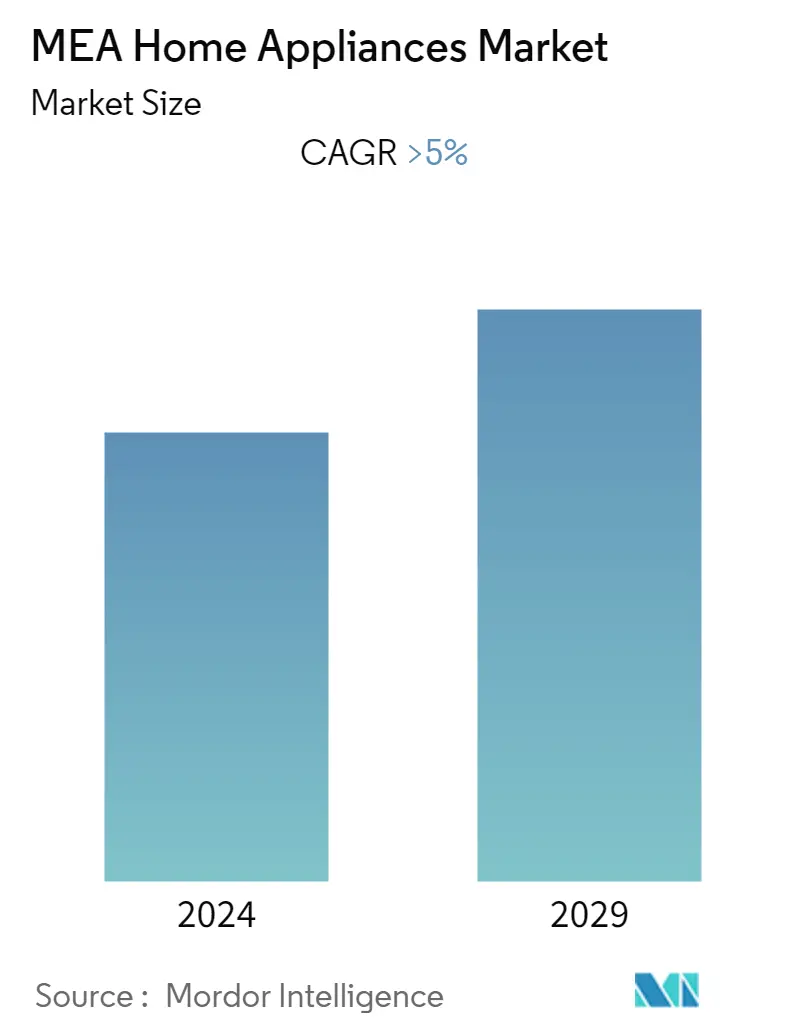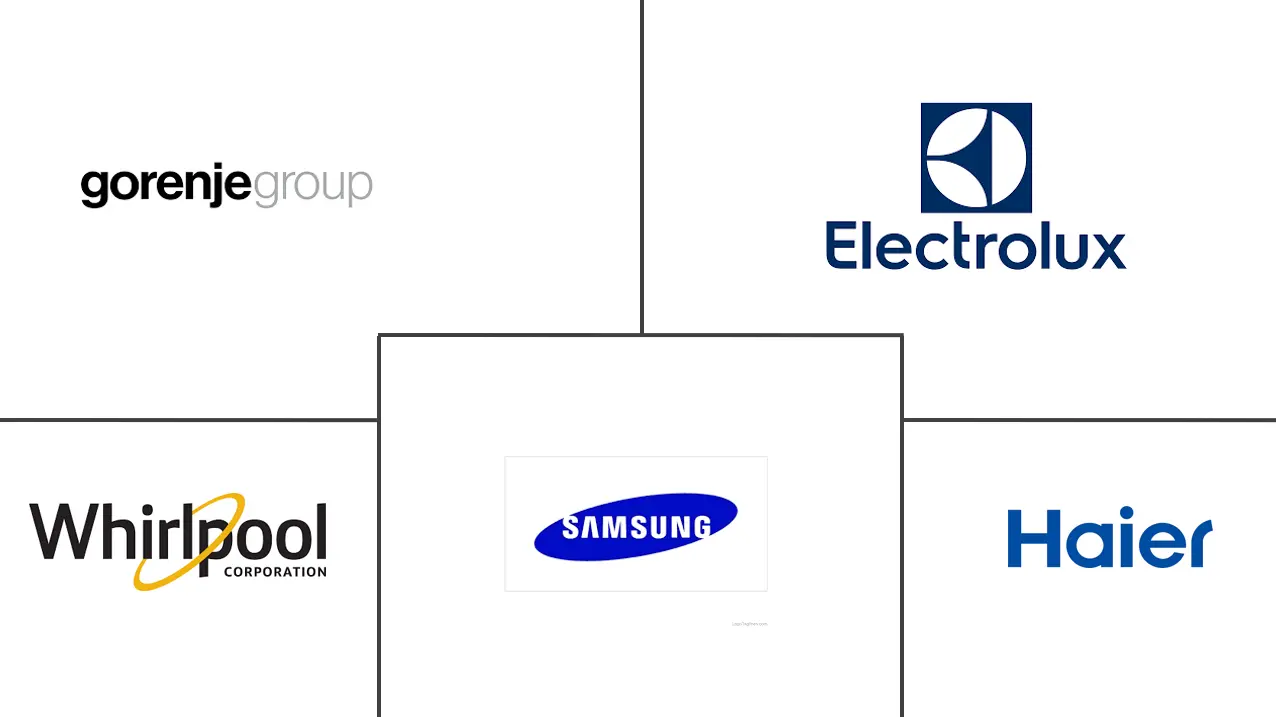Market Size of MEA Home Appliances Industry

| Study Period | 2020 - 2029 |
| Base Year For Estimation | 2023 |
| Forecast Data Period | 2024 - 2029 |
| Historical Data Period | 2020 - 2022 |
| CAGR | 5.00 % |
| Market Concentration | Medium |
Major Players
*Disclaimer: Major Players sorted in no particular order |
MEA Home Appliances Market Analysis
The Middle East and Africa region is a mixture of different economies of which parts of the region are recovering from the economic crisis whereas some parts are performing financially well. The difference balances the market share for the region and the home appliances market in the Middle East and Africa is conjectured to grow eventually and score a growth number over the forecasted period. The Middle East and Africa Home Appliances Market is poised to grow at a CAGR of 5% by 2028. One thing that stays almost common across the region is the similarity among the consumers. The consumers are of high quality and price sensitive. They look for value for money and once the product satisfies their requirements, they are ready to experiment among the brands. The brands which offer value-added services like periodic after-sale service, extended warranty, replacing a faulty part if required, and simple and quick procedures of communication and servicing are the factors that are affecting the consumers' decision-making once they get a product that fits their requirements of quality and price.
Growing demand for new appliances has also been seen in the region with the high number of replacement cycles of old appliances. The increasing construction activities in most parts of the Middle East region are contributing to the market for inbuilt appliances. The observations from the study period revealed that there has been an increase in demand for compact and energy-efficient appliances. The drastically changing climatic conditions are also driving the manufacturers towards manufacturing such products. It is becoming a challenge for the manufacturers to reach the requirements of customers who are dynamic about their preferences. The demand for energy-efficient products is being followed by more compact models and the sleeker designs.
The impact of the Covid-19 crisis on consumer behavior and manufacturing trends has heightened the importance of digitalization and automation for the Home Appliances Market. Online-savvy consumers seeking personalized shopping experiences and competitive prices are pushing Home Appliances manufacturers to innovate on their existing workflows
MEA Home Appliances Industry Segmentation
A complete background analysis of the Middle East and Africa Home Appliances Industry, which includes an assessment of the industry associations, overall economy, and emerging market trends by segments, significant changes in the market dynamics, and market overview is covered in the report. Middle East and Africa Home Appliances Market is Segmented by Major Appliances (Refrigerators, Freezers, Dishwashing Machines, Washing Machines, and Cookers & Ovens), Small Appliances (Vacuum Cleaners, Small Kitchen Appliances, Hair Clippers, Irons, Toasters, Grills & Roasters, and Hair Dryers), Distribution Channel (Supermarkets & Hypermarkets, Specialty Stores, E-Commerce and Others). The Report Offers Market Size and Forecasts for the Middle East and Africa Home Appliances Market in Value (USD Billion) for all the above Segments.
| Major Appliances | |
| Refrigerators | |
| Freezers | |
| Dishwashing Machines | |
| Washing Machines | |
| Cookers & Ovens |
| Small Appliances | |
| Vacuum Cleaners | |
| Small Kitchen Appliances | |
| Hair Clippers | |
| Irons | |
| Toasters | |
| Grills & Roasters | |
| Hair Dryers | |
| Others |
| Distribution Channel | |
| Supermarkets & Hypermarkets | |
| Specialty Stores | |
| E-Commerce | |
| Others |
MEA Home Appliances Market Size Summary
The Middle East and Africa home appliances market is experiencing a gradual recovery and growth, driven by a mix of economic conditions across the region. Consumers in this market are characterized by their high quality and price sensitivity, seeking value for money and being open to brand experimentation once their quality and price requirements are met. The demand for new and energy-efficient appliances is on the rise, fueled by frequent replacement cycles and increasing construction activities, particularly in the Middle East. Manufacturers are challenged to meet the dynamic preferences of consumers, who are increasingly favoring compact and sleek designs. The impact of digitalization and automation has become more pronounced, with online-savvy consumers pushing for personalized shopping experiences and competitive pricing.
The COVID-19 pandemic initially disrupted the UAE home appliance industry due to global trade interruptions, but recovery measures have led to progressive economic stabilization. South Africa has also emerged from recession, contributing to market growth. Local manufacturers have benefited from economic instability by achieving moderate sales through strategies like discounts and promotions. While there is a shift towards online shopping, offline sales remain significant, with hypermarkets and multi-brand stores maintaining a strong market presence. The region offers opportunities for new entrants and online distributors, with major players like Whirlpool, Gorenje, Electrolux, Samsung, and Haier holding a strong presence. Strategic partnerships, such as Gorenje's with Better Life and Samsung's with TOD, are enhancing market reach and product offerings.
MEA Home Appliances Market Size - Table of Contents
-
1. MARKET INSIGHTS AND DYNAMICS
-
1.1 Market Overview
-
1.2 Market Drivers
-
1.3 Market Restraints
-
1.4 Value Chain Analysis
-
1.5 Porters 5 Force Analysis
-
1.6 Technological Innovations
-
1.7 Impact of COVID-19 on the Market
-
-
2. MARKET SEGMENTATION
-
2.1 Major Appliances
-
2.1.1 Refrigerators
-
2.1.2 Freezers
-
2.1.3 Dishwashing Machines
-
2.1.4 Washing Machines
-
2.1.5 Cookers & Ovens
-
-
2.2 Small Appliances
-
2.2.1 Vacuum Cleaners
-
2.2.2 Small Kitchen Appliances
-
2.2.3 Hair Clippers
-
2.2.4 Irons
-
2.2.5 Toasters
-
2.2.6 Grills & Roasters
-
2.2.7 Hair Dryers
-
2.2.8 Others
-
-
2.3 Distribution Channel
-
2.3.1 Supermarkets & Hypermarkets
-
2.3.2 Specialty Stores
-
2.3.3 E-Commerce
-
2.3.4 Others
-
-
MEA Home Appliances Market Size FAQs
What is the current MEA Home Appliances Market size?
The MEA Home Appliances Market is projected to register a CAGR of greater than 5% during the forecast period (2024-2029)
Who are the key players in MEA Home Appliances Market?
Gorenje Group, Electrolux AB, Samsung Electronics, Whirlpool Corporation and Haier Electronics Group Co. Ltd, are the major companies operating in the MEA Home Appliances Market.

